Wildflowers of Alberta, British Columbia, Yukon & Alaska Summer 2012

I really don't know much about flowers, but I am trying to learn. I used pamphlets and the internet trying to identify some of the flowers I photographed. So I'm not guaranteeing the accuracy of anything in this blog. If you see any errors, I would appreciate being corrected.

There are over 1,500 varieties of wildflowers in the Yukon alone.
One of three varieties of Ladyslippers that grow in the Yukon. There is also a white one and a pinkish, purple one. It is very fragile and can take up to fifteen years to flower.
 And who says Dandelions aren't beautiful. I read somewhere that there are fourteen varieties of dandelions. The grizzly bears love them and we saw them grazing on them in the roadside ditches several times. They grew in huge clumps here like a bouquet, two feet tall with flowers an inch and a half in diameter.
And who says Dandelions aren't beautiful. I read somewhere that there are fourteen varieties of dandelions. The grizzly bears love them and we saw them grazing on them in the roadside ditches several times. They grew in huge clumps here like a bouquet, two feet tall with flowers an inch and a half in diameter. The dandelion is a common perennial herb of the sunflower family. The flower is used to make wine and the leaves can be cooked or eaten raw in salads. Coffee can be made from the ground roots.

They all cross with each other and create hybrids.
This one is the Yukon Lupine, which is found in abundance in the Carcross Dunes. It is thought to have evolved from the Bering Strait.


Gorman's Beardtongue.
Bear-root or Indian Potato is another similar roadside plant. It's carbohydrate-rich roots are edible and, when roasted or boiled, taste similar to potatoes or carrots.

Bunch Berry or Dwarf Dogwood are a low, ground cover type of plant.
Tall Lungwort or Tall Bluebells. Leaves are edible and a tasty addition to a summer salad.
Labrador Tea is used to make a distinctive tea.
The yellow flower here is Narrowleaf Hawksbeard from the Sunflower family, an invasive plant that grows along the major highways. I'm not sure what the flower in the foreground is. It might be Showy Crazyweed, Showy Locoweed, which causes the disease "Locoism" in livestock, but bears eat it with no effect.
Calypso, Lady's Slipper, named after the sea-nymph daughter of Atlas in Greek Mythology. It is the official flower of Prince Edward Island.
Twinflower is a small, creeping evergreen plant that grows in pairs on a Y-shaped stalk. It grows well in the shade on forest floors.
Narrow-leaved Arnica of the Sunflower family has been used as a topical herbal remedy for everything from bruises to hair loss. It should not be ingested, as it can be fatal in large quantities. Yukon Goldenweed looks very similar to this and is one of five Yukon plants found nowhere else on earth.
Columbines.
 I think this is Mountain Death Camas of the lily family. It causes vomiting, decreased body temp, difficulty breathing and coma.
I think this is Mountain Death Camas of the lily family. It causes vomiting, decreased body temp, difficulty breathing and coma. Lousewort.
Lousewort. Indian Paintbrush and Cotton Grass. There are many varieties of Cotton Grass. I think the yellow one above is Yukon Paintbrush and the purple one above that is Raup's Paintbrush. There are species of paintbrush in the Yukon.
Golden Clematis.
Fireweed, the territorial flower of the Yukon. This is one of the most common flowers all across the northwest. They spring to life after forest fires and cover the hillsides. They can get 8 to 9 feet tall. We did see some that were over 6 feet tall.
This is at the harbor in Seward.
This is right out the front window of our camper, looking across the bay toward Valdez.
Looking toward the oil refinery at Valdez, at the end of the 800 mile pipeline from Prudhoe Bay.
Fireweed blooms from the bottom up. It is sometimes called the "Sourdough Calendar" as the natives use it to measure the passing of the summer. By the time the tops bloom, it is an indication of approaching winter. A Sourdough is an old timer. A newcomer is called a Cheechako.
The cotton from the trees and other plants catch in the stems, as another indicator of the end of summer.

Wild Strawberry?

Mountain Avens?

Horsetail has silica in it and is very abrasive. Natives used it to scour out their cooking utensils.


Unusual looking mushrooms.

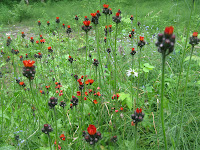
These interesting looking flowers were growing all over at the Talkeetna Cemetery, where many who lost their lives attempting to climb Denali are buried.

Oxeye Daisies while hiking along Knik Arm of Cook Inlet in Anchorage.

Red Clover.




Buttercup?
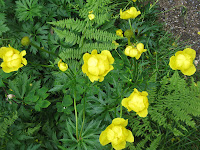

Ross Avens?

Wood strawberry?

Alaska Poppy.
Largeleaf Avens? on the beach of the Homer Spit.
Foxtail Barley. I also heard it call Red Squirrel Grass.
Jakutsk Snow-parsley named after the city in Siberia.
 Cow Parsley overlooking the Homer Spit on Kachemak Bay where we took a cruise out to Gull Island and Halibut Cove.
Cow Parsley overlooking the Homer Spit on Kachemak Bay where we took a cruise out to Gull Island and Halibut Cove.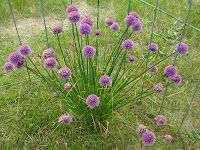 I think this is chives. It was planted next to an old grave on a hilltop we hiked to in Halibut Cove.
I think this is chives. It was planted next to an old grave on a hilltop we hiked to in Halibut Cove.
Alpine Harebell, looking down over the side of a cliff on Halibut Cove.
Northern Star Flower?
Watermelon Berry. The picture above shows the tiny white flowers that hang underneath the leaves before the berries appear. This was by the waterfall, above the cemetery at Skagway.

Wild Geranium or Sticky Purple Geranium.
Larkspur.
Northern Monkshood has dark blue and purple flowers that are shaped like the hood of a monk's robe. All parts of this plant are extremely poisonous, especially the roots and seeds. It causes loss of feeling, sweating, decreased body temp, respiratory difficulty and, in high doses, cardiac arrest.
The Chocolate Lily is pollinated by flies and smells like a dead moose carcass to attract the flies. The edible bulbs can be cooked like rice.
Pink Pyrolia or wintergreen is also thick ground cover in the alpine forest.
This is the back of a leaf from a trembling or quaking Aspen. The leaves all look white on the backside, but they are just infested with some bug that tunnels around on them and changes their color.
 Soap Berries? There are so many kinds of berries up here and it is not uncommon to see people pulled over and picking berries on the road side. There are blueberries, huckleberries, crow berries, low and high bush cranberries, salmon berries raspberries, service berries, elderberries, goose berries, lingonberries, buffalo berries, dog berries, pumpkin berries,mossberries, nagoonberries, wineberries, cloudberies, red and black currants, etc. A bear's paradise.
Soap Berries? There are so many kinds of berries up here and it is not uncommon to see people pulled over and picking berries on the road side. There are blueberries, huckleberries, crow berries, low and high bush cranberries, salmon berries raspberries, service berries, elderberries, goose berries, lingonberries, buffalo berries, dog berries, pumpkin berries,mossberries, nagoonberries, wineberries, cloudberies, red and black currants, etc. A bear's paradise.  Rose Hips, edible, best after first frost.
Rose Hips, edible, best after first frost. 
Siberian Asters are eaten by a number of wildlife species, especially deer and moose.

Devils Club grows so thick and tall on the forest floor, you can hardly walk through it.
 Northern Yarrow at Halibut Cove.
Northern Yarrow at Halibut Cove.  Oxeye Daisies.
Oxeye Daisies.Forget-Me-Not is the state flower of Alaska.
I believe the flower below is Jacob's Ladder, named after the leaves that are shaped like a ladder. For some reason, it would not let me make these last two pictures smaller.
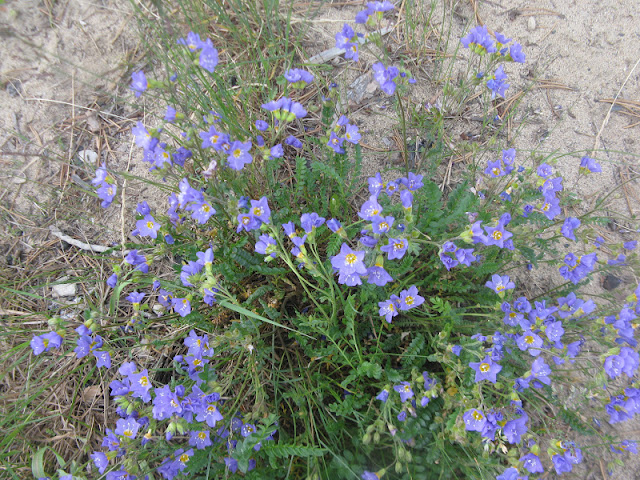 |
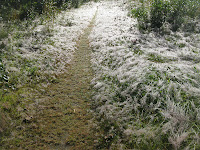 This shows the dew along a walking path next to our campground in Haines, Alaska. So much moisture, probably why things grow so well here, along with the long days. While the hot, dry days were going on in the midwest this summer, we rarely had high temps much over 70 and it rained quite often.
This shows the dew along a walking path next to our campground in Haines, Alaska. So much moisture, probably why things grow so well here, along with the long days. While the hot, dry days were going on in the midwest this summer, we rarely had high temps much over 70 and it rained quite often.
Tarra












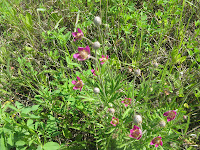
















































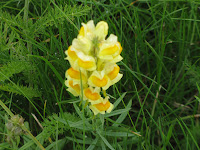



No comments:
Post a Comment